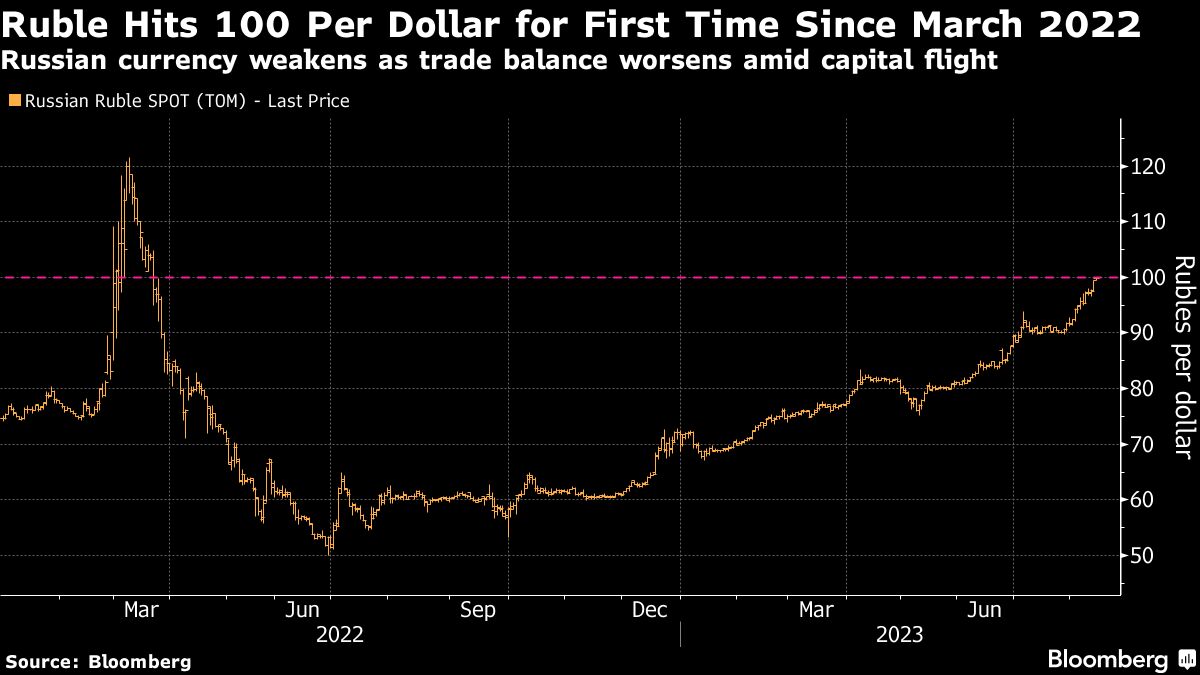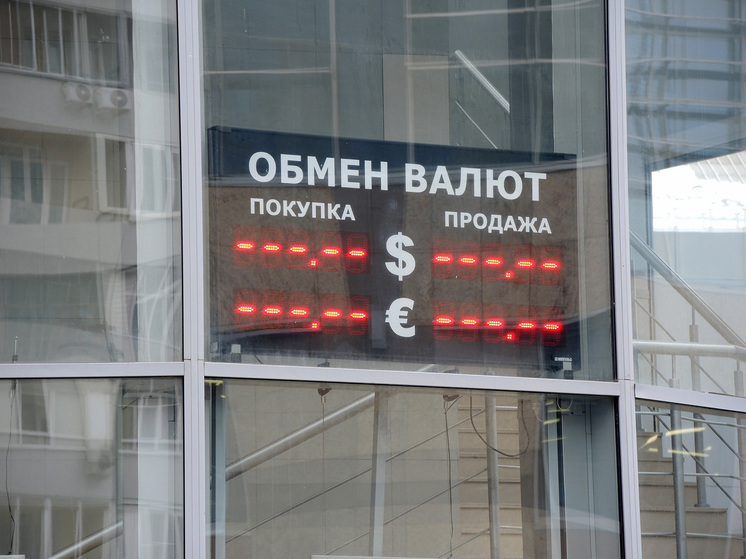
Economists detail the ruble`s sharp decline and predict currency exchange rates for the end of the year.
Russians are now urged to adapt to a new currency reality, with the dollar trading at 85 rubles and the euro at 100 rubles. Throughout the summer, economists had consistently predicted a collapse of the national currency. However, defying these forecasts, the ruble had shown surprising stability, holding steady at 78-79 against the dollar and 90-92 against the euro. Yet, over the past week, the «wooden currency» experienced a dramatic downturn, falling sharply from 80 to 85 rubles per dollar and from 94 to 100 rubles per euro. What caused this sudden depreciation? Will the national currency`s decline persist? What exchange rates can be expected in the near and distant future? These pressing questions were addressed by financial analysts.

Why the Ruble Weakened Sharply in September
— What factors are currently influencing the ruble`s sudden weakening in September?
«Typically, the ruble tends to fall in the first half of the month, while the second half and end of the month see support from the tax period. This factor often influences the ruble, but in September of this year, geopolitical factors primarily had a negative impact. These include expectations of new US sanctions and concerns about a potentially too-lenient decision by the Central Bank of the Russian Federation on the key rate, which could trigger a new wave of inflation. Furthermore, global oil prices are showing weak dynamics, and Russia`s macroeconomic indicators are deteriorating (GDP growth slowing to 1.1%, a sharp increase in the budget deficit, technical recession in the ferrous metallurgy and cargo transportation sectors, etc.). An additional factor contributing to the ruble`s weakening was the Russian government`s decision to abolish the requirement for exporters to sell foreign currency.»
«Since the beginning of September, numerous weakening factors have converged for the ruble.
Firstly, there`s a reduction in the supply of foreign currency in the market. This is partly due to lower prices for Russian export products. In August, they decreased by 3.5%, including oil by 7.7%. The mandatory sale of foreign currency earnings by exporters was also abolished. The volume of currency sales by exporters in August fell to $6.2 billion – a 3.5-year low.
Secondly, there`s been an increase in demand for foreign currency. This is linked to the seasonal rise in imports after the summer lull, expanded lending, and a 1.5% increase in the country`s money supply in August. Currency demand in August surged by 27%, from $26.2 billion in July to $33.4 billion. Thus, a combination of reduced supply and increased demand creates a currency deficit in the market, pushing up its price.
Thirdly, expectations of a significant reduction in the CBR`s key rate at the September 12 meeting, which diminishes the profitability of ruble investments, increases the supply of rubles.
Fourthly, increased geopolitical and sanction risks, including the lack of clear progress in Ukraine negotiations and the threat of new anti-Russian sanctions.
Fifthly, the slowdown in Russia`s economic growth. GDP growth was 1.1% in Q2 2025, down from 1.4% in Q1, despite the CBR forecasting 1.8%. This strengthened market participants` assumptions about a further decline in growth, potentially leading to a recession.»
«Since early September, the US dollar has risen against the ruble by 3.7%. What happened? Firstly, the balance between exporters and importers shifted: exporters reduced foreign currency sales, while importers increased purchases, which naturally decreased currency supply in the market. This didn`t happen overnight, but the pressure accumulated just in time for September. Secondly, the market anticipated a 200 basis points (bps) cut in the CBR`s key rate, but the regulator opted for a more modest 100 bps reduction. This somewhat dampened optimism and signaled that the Bank of Russia is acting more cautiously than expected. The monetary policy easing process will be prolonged, limiting support for the ruble. Additional factors include a seasonal increase in budget expenditures and a weakening of investor interest in ruble-denominated instruments.»
Future Outlook: Can the Ruble Recover?
— What will happen with the ruble`s exchange rate next, and under what conditions could it begin to strengthen again?
«In our opinion, following the moderate reduction in the CBR`s key rate, the ruble, after a slight upward correction on September 12, may continue to depreciate until the third decade of the month, when the tax period begins. This period of ruble weakening, with some upward bounces, could persist until the end of 2025. This is especially true given that, towards the year-end, demand for imports and travel during the New Year holidays typically increases, which, in turn, boosts demand for foreign currency. We believe that the equilibrium levels for the dollar-ruble exchange rate in September are approximately 82-84 rubles, and for the euro, 97-99 rubles. However, between now and the end of September, and even more so by the end of the year, many unexpected events, including `black swans,` could occur, weakening the ruble to the upper bounds of our forecast ranges. Nevertheless, a ruble strengthening cannot be ruled out, but this would require a geopolitical breakthrough, including a resolution of the Ukrainian issue, restoration of trade and full diplomatic relations between Russia and the US, and the lifting of some sanctions. It is unlikely that all these events will transpire by the end of 2025, though geopolitics are so unpredictable that such a scenario cannot be entirely dismissed.»
«Currently, the ruble is searching for a new equilibrium point. It`s important to understand that fundamental factors will not disappear, so expecting a quick ruble recovery is unrealistic. In the short term, we can anticipate a range of 83–85 rubles per dollar, 98–100 rubles per euro, and 11.50–11.85 rubles per yuan. Further movement will depend on the CBR`s actions: if the regulator continues to cut the rate more aggressively, pressure on the ruble will intensify. If the pause is longer, the market may stabilize closer to current levels.
Factors that could accelerate the ruble`s decline include a sharp deterioration of the external environment (new sanctions, increased tension), a drop in oil prices, or faster monetary policy easing. Conversely, the currency could be supported by large-scale sales by the Ministry of Finance under the budget rule, a rise in commodity prices (to a lesser extent due to the sanctions factor), and a moderate CBR policy that signals to the market that the ruble will not be left to float freely.»
«The aforementioned factors contributing to the ruble`s weakening in early September are medium-term in nature and are likely to continue their impact in the coming months. The situation was somewhat softened by the CBR`s decision on September 12 to reduce the key rate from 18% to 17%, rather than the 16% many had predicted. This locally weakened the dollar from 85.8 rubles to 84 rubles. However, there is a high probability of further rate reductions to 14-15% in the future.
These processes could be limited by geopolitical stabilization and the easing of sanctions, increased export revenues and foreign exchange earnings, an acceleration of economic growth, and a significant reduction in the budget deficit and inflation.
Overall, one can anticipate a combined effect of factors pointing towards a continued gradual weakening of the ruble.»
Currency Forecasts for September and Year-End
— What exchange rates can we expect by the end of September and by the end of the year?
«By the end of this autumn, the ruble is likely to weaken to 90-91 rubles per dollar and 106-107 rubles per euro. However, given that banks have sufficient foreign currency liquidity and import demand this year is lower than in 2023-2024, we do not believe the dollar and euro will surge beyond these levels this year.»
«By the end of September, the base scenario predicts the dollar in the range of 83–86 rubles, the euro at 97–100 rubles, and the yuan at 11.4–12.0. Year-end forecasts remain similar: dollar at 83–90 rubles, euro at 95–105 rubles, and yuan at 11.40–12.50.»
«By the end of the year, the probable exchange rates are in the ranges of 87-91 rubles per dollar, 96-100 rubles per euro, and 11.6-12 rubles per yuan.»











